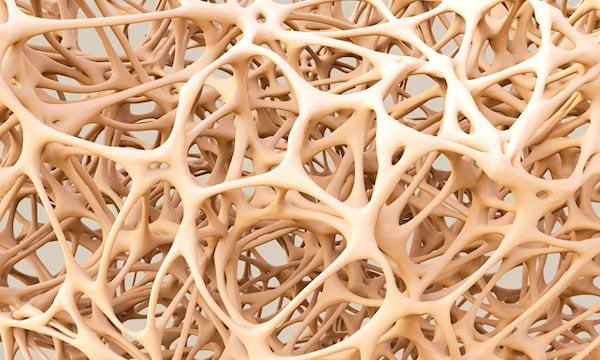
The way bone formation takes place must be rewritten. This has been demonstrated by a publication of researchers from Radboudumc, a university medical center in Nijmegen, Netherlands, and colleagues at Nature Communications. Bone formation does not require complex biomolecules in collagen at all. Making bone substitutes and biomaterials is therefore easier than previously thought.
Bones are indispensable. They form the underlying structure for our muscles, allowing us to move. They also protect vulnerable organs such as brains and lungs and house stem cells that produce our blood and immune system. There are no people without bones. Apparently, bones are very simple things, consisting mainly of a mixture of collagen and calcium phosphate. But that’s not the whole story.
Biomolecules
Ten years ago, Nico Sommerdijk published an article in Nature Materials in which he and his colleagues demonstrated that nothing more is needed other than collagen (long strands of connective tissue) and tiny crystals of calcium phosphate. “Exactly how those crystals in that collagen grow into small plates and group together like tiles, that was not known,” says Sommerdijk, biochemical researcher at Radboudumc. “The generally accepted idea was that bioactive molecules of that collagen thread the crystals together to form plates that are 3 nanometers thick, 20 nanometers wide and 65 nanometers long.” A nanometer is one billionth of a meter.
These processes could not be visualized on such a tiny scale ten years ago. But Sommerdijk soon doubted the idea that was being embraced by “the field.” “When we replaced the calcium phosphate with other minerals, the same tiny plates were created. Bioactive molecules are very selective, so we immediately doubted that dominant idea,” comments Sommerdijk. What follows is a scientific Sisyphean task against the established order, which after ten years he has now concluded in his favor with this publication in Nature Communications.
Against the current
The first thing Sommerdijk debunks is the stacking of the crystallized plates “like playing cards in a box.” By using an electron microscope at different angles to make about one hundred two-dimensional shots of bone, he creates three-dimensional images that show something different. The images may all lie in the longitudinal direction of the collagen, but certainly not like neatly stacked playing cards against each other. Over and over again there are images showing plates lying at different angles against each other.

Together with the expert who first published the structure of collagen in 2006 and a specialist who studies crystallization in small spaces, the function of the collagen is then examined in detail. Collagen appears to have thin, longitudinal cavities in which calcium phosphate enters that then crystallizes. “This does not happen under the guidance of bioactive molecules in the collagen, but is a blind process dominated by the laws of physical chemistry,” says Sommerdijk. “Calcium phosphate that crystallizes longitudinally has a selection advantage, precisely because of those thin collagen cavities. Initially, this only creates very thin needles in such a cavity. The needle then grows into a small plate of calcium phosphate which pushes away the surrounding collagen.”
Step by step
In the human body, the process of bone growth cannot be followed closely. Working closely with cellular biologist Anat Akiva at Radboudumc, Sommerdijk used a model in which bone growth can be imitated outside an organism. There he can observe the process happening step by step. The end result is comparable to what he finds in human bone material that sometimes becomes available after surgery. “Step by step we have thus provided a new foundation for the way our bones are formed, how they grow and how they harden.”
This fundamental research also has consequences in practice, says Akiva. “If the growth of crystals doesn’t have to take place in a matrix with very complex and expensive biomolecules but can also take place in channels of cheap polymer instead, then making biomaterials and bone replacements becomes a lot easier, without having to compromise on the properties of these materials. That also makes our finding important for the patient.”
Not the whole story
With the article in Nature Communications, the image of bone formation should definitely be overturned. But discoveries about the process of bone formation is not the whole story, says Sommerdijk: “Bone is not only formed inside, but also outside the collagen. Various proteins seem to play a role in this process. With a European Research Council advanced grant of €3.5 million that he received previously, he is now trying to gain more insight into this.

